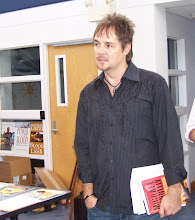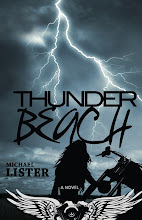
Hard Case Crime’s first fifty books haven’t been easy, but founders Charles Ardai and Max Phillips never expected them to be. After all, they didn’t name their publishing venture Easy Case.
As the company celebrates its fifth year and fiftieth book, I interviewed editor and co-founder, Charles Ardai, about the house, its books, and the history of pulp fiction.
It began, like so many good stories do—with somebody falling in love . . .
“Max Phillips and I both fell in love with the pulp paperback crime novels of the post-war era after finding them at yard sales and garage sales and in libraries when we were growing up,” Ardai said. “Here were these irresistibly lurid, clever, intense, exciting books with gorgeous cover paintings, books that were slender and inexpensive and unpretentious but packed a terrific storytelling punch.”
They say that the best business minds look for a need and meet it, ask what’s missing and answer it, discover a gap and fill it. That’s exactly what Ardai and Phillips did.
“So one night in the winter of 2001,” Ardai said, “we asked each other why we didn’t just start a publishing operation of our own, to revive this wonderful old style of crime novel. And Hard Case Crime was the result.”
Nothing worth anything is easy, but building a publishing house in today’s market . . .
“Starting a book publishing company is not something anyone rational would do purely for business reasons,” Ardai added. “You have to be a little crazy and you have to be doing it at least partly for love.
“Having come up with the idea, it then took us two full years to find a publisher willing to work with us in the way we wanted. We knew we could pick great books and make them look wonderful—but we knew nothing about actually printing and warehousing and selling and distributing. I met with nearly every major publisher in the business and some minor ones, too, and while pretty much all of them liked the premise (you could see that some of them were salivating at the sight of the covers), most of the big houses were reluctant to get involved, out of fear that we’d never sell enough copies of these books to make it worth their while as a commercial (rather than a purely aesthetic) undertaking. Some publishers were game to give it a try, but only in hardcover or the large, modern trade paperback format—but we really wanted to recreate a specific historical artifact and publishing in those formats just wouldn’t have been the same. So, one by one, we talked with all the publishers out there, and then finally we turned up what turned out to be the perfect partner: Dorchester Publishing, the oldest independent mass market publisher in the country and a true heir to the old paperback houses of the pulp era.”
A lot can happen in five years and fifty books. I asked Ardai to share some of the highs and lows.
“Oh, there are so many of both—where to start? A low point: The first two years of pitching, pitching, pitching, when everyone said “I love it” but no one had yet said “I’ll do it.” We didn’t know if we’d ever be able to convince anyone to let us prove we had something that people would love. A high point: Seeing our first two books hit stores, one by my long-time favorite crime writer, Lawrence Block, the other by my co-founder, Max Phillips. Then, the next month, came another high point: Seeing my own first novel hit stores, behind a cover by the legendary illustrator Robert McGinnis. Low point: When Alan Furst and Gore Vidal told us they would not give us their blessing to reprint their early pulp fiction, even though it’s excellent. High point: When Stephen King said he wanted to write a new book for us. Low point: When first Ed McBain and then Richard Prather and then Mickey Spillane died. High point: Getting to work with giants of the field like McBain and Prather and Spillane, who were all heroes of mine when I was growing up. High point: Watching some of the finest pulp illustrations get painted at our direction by artists whose work is mouth-wateringly good. High point: Seeing our work written up enthusiastically in Time magazine and the “New York Times” and “Playboy,” seeing Hard Case Crime featured on CBS and NPR. High point: Winning the Edgar and the Shamus, both for other people’s work and then for my own. Low point: Realizing that it can’t go on forever—nothing ever does. High point: Knowing it’s gone on this long, that I can point to a shelf filled with 50 excellent books and say, “I did that. I put those in people’s lives and gave pleasure to hundreds of thousands of readers.” And knowing we’ve got the next year’s titles all spec’d out already. Definitely more high points than low. And I’m excited to see what the future will bring.”
The thirteenth book published by Hard Case was by one of the best-selling novelist of all time, Stephen King—interestingly, that book was part of my very first review column. I asked Ardai how he managed to snag an author like King and what it did for the company.
“Stephen King’s book for us, “The Colorado Kid,” has been our best-selling title to date by far, selling almost as many copies as all our other books combined. (The initial print run for the book was more than one million copies.) And the book definitely did help put Hard Case Crime on the map, even though by the time it appeared we'd already published a dozen titles, won an Edgar and a Shamus, appeared in “USA Today” and dozens of other publications, and generally been well received. But having an original novel by Stephen King catapulted the line to a level of public awareness and attention we could never have achieved otherwise. It was very generous of Steve to let us publish the book—and though it’s not your typical Hard Case Crime title (as Steve himself said, it's more "bleu" than "noir"), it’s one I’m extremely fond of and proud to have published. How did it come about? In short, I knew that Steve was a fan of old-fashioned pulp crime fiction since he's said so in numerous places, and I approached him to see if he’d consider writing a blurb for the series. He thought about it for a while and then came back and said he did not want to write a blurb, he wanted to write a book for us instead. Needless to say, I was thrilled.”
Next: The Long Hard Look (Part II)












No comments:
Post a Comment